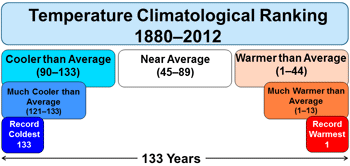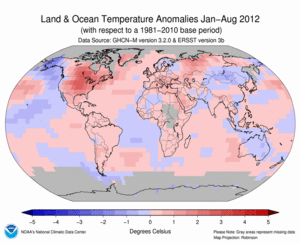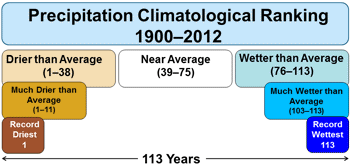 August 2012 Selected Climate
August 2012 Selected Climate
Anomalies and Events Map
Global Highlights
- The average combined global land and ocean surface temperature for August 2012 was 0.62°C (1.12°F) above the 20th century average of 15.6°C (60.1°F). This is the fourth warmest August since records began in 1880.
- The globally-averaged land surface temperature for August 2012 was the second warmest August on record, at 0.90°C (1.62°F) above average, while the globally-averaged ocean surface temperature was the fifth warmest on record, at 0.52°C (0.94°F) above average.
- ENSO-neutral conditions continued in the eastern equatorial Pacific Ocean during August 2012. El Niño conditions are likely to emerge in September.
- The average combined global land and ocean surface temperature for June–August 2012 was 0.64°C (1.15°F) above the 20th century average of 15.6°C (60.1°F), marking the third warmest June–August on record.
- The globally-averaged land surface temperature for June–August 2012 was the all-time warmest June–August on record, at 1.03°C (1.85°F) above average.
- The combined global land and ocean average surface temperature for January–August 2012 was the ninth warmest such period on record, at 0.56°C (1.01°F) above the 20th century average.
Introduction
Temperature anomalies and percentiles are shown on the gridded maps below. The anomaly map on the left is a product of a merged land surface temperature (Global Historical Climatology Network, GHCN) and sea surface temperature (ERSST.v3b) anomaly analysis developed by Smith et al. (2008). Temperature anomalies for land and ocean are analyzed separately and then merged to form the global analysis. For more information, please visit NCDC's Global Surface Temperature Anomalies page. The August 2012 Global State of the Climate report introduces percentile maps that complement the information provided by the anomaly maps. These new maps on the right provide additional information by placing the temperature anomaly observed for a specific place and time period into historical perspective, showing how the most current month, season or year compares with the past.
Temperatures
In the atmosphere, 500-millibar height pressure anomalies correlate well with temperatures at the Earth's surface. The average position of the upper-level ridges of high pressure and troughs of low pressure—depicted by positive and negative 500-millibar height anomalies on the 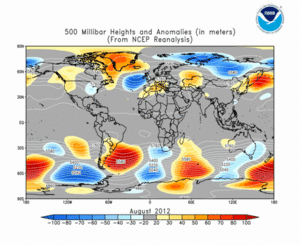 August 2012 and the
August 2012 and the 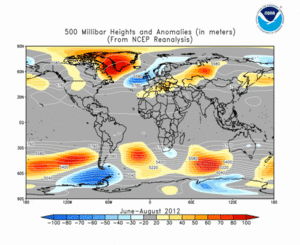 June–August 2012 maps—are generally reflected by areas of positive and negative temperature anomalies at the surface, respectively.
June–August 2012 maps—are generally reflected by areas of positive and negative temperature anomalies at the surface, respectively.
August
Did You Know?
Expand "Global Temperature Anomaly Percentile Maps"
Global Temperature Anomaly Percentile Maps
Global anomaly maps are an essential tool when describing the current state of the climate across the globe. Temperature anomaly maps tell us whether the temperature observed for a specific place and time period (for example, month, season, or year) was warmer or cooler than a reference value, which is usually a 30-year average, and by how much.
The August 2012 Global State of the Climate report introduces percentile maps that complement the information provided by the anomaly maps. These new maps provide additional information by placing the temperature anomaly observed for a specific place and time period into historical perspective, showing how the most current month, season or year compares with the past.
In order to place the month, season, or year into historical perspective, each grid point's temperature values for the time period of interest (for example all August values from 1850 to 2012) are sorted from warmest to coolest, with ranks assigned to each value. The numeric rank represents the position of that particular value throughout the historical record. The length of record increases with each year. It is important to note that each grid point's period of record may vary, but all grid points displayed in the map have a minimum of 80 years of data. For the global temperature anomaly record, the data does extend back to 1850. But not all grid points have data from 1850 to present. Considering a grid point with a period of record of 163 years, a value of "1" in the temperature record refers to record warmest, while a value of "163" refers to record coldest.
The Warmer than Average, Near Average, and Cooler than Average shadings on the temperature percentile maps represent the bottom, middle, and upper tercile (or three equal portions) of the sorted values or distribution, respectively. Much Warmer than Average and Much Cooler than Average, refer to the lowest and uppermost decile (top or bottom 10 percent) of the distribution, respectively. For a 163-year period, Warmer than Average (Cooler than Average) would represent one of the 54 warmest (coolest) such periods on record. However, if the value ranked among the 16 warmest (coolest) on record, that value would be classified as Much Warmer than Average (Much Cooler than Average). Near Average would represent an average temperature value that was in the middle third (rank of 55 to 109) on record.
The average global temperature across land and oceans during August 2012 was 0.62°C (1.12°F) above the 20th century average of 15.6°C (60.1°F) and ranked as the fourth warmest August since records began in 1880. Monthly global temperatures anomalies have been among the five highest for their respective months for five consecutive months, since April 2012. August 2012 marks the 36th consecutive August and 330th consecutive month with a global temperature above the 20th century average. The last below-average August temperature was August 1976 and the last below-average temperature for any month was February 1985. At the hemispheric scale, the Northern and Southern Hemisphere each also ranked as fourth warmest on record.
ENSO-neutral conditions continued during August across the central and eastern equatorial Pacific Ocean, with average sea surface temperatures in this region trending toward a three-month average of 0.5°C (0.9°F), the threshold for El Niño conditions. Spurred by the warming temperatures in the equatorial Pacific, the average global ocean temperature rose during August to 0.52°C (0.94°F) above average, tying with 2006 as the fifth warmest August on record. This is also the warmest anomaly for any month since July 2010, the month when the La Niña conditions that dominated from the latter half of 2010 through early 2012 first emerged. According to NOAA's Climate Prediction Center, El Niño conditions will likely emerge during September 2012.
Over land, the monthly average global surface temperature for August was 0.90°C (1.62°F) above the long-term average, tying with 2001 and 2011 as the second warmest August in the 133-year period of record, behind 1998. The Southern Hemisphere land tied with 2005 as the third warmest (0.86°C / 1.55°F above average) while the Northern Hemisphere land ranked seventh warmest (0.91°C / 1.64°F above average). The greatest anomalous warmth occurred across far eastern Canada, southern Greenland, central and southern Europe, western Kazakhstan, Japan, Western Australia, and Paraguay. Parts of Siberia were notably cooler than average.
- The Bureau of Meteorology reported that the average August maximum (daytime) temperature across Australia was 1.49°C (2.68°F) above the 1961–1990 average, making this the sixth warmest August since national records began in 1950. Every state and territory across the country also reported above-average monthly maximum temperatures. However, while the country was warmer than average during the day, it was also colder than average at night. The August minimum (nighttime) temperature across Australia was 0.83°C (1.49°F) below average. The difference between the average maximum temperature and the average minimum temperature was the greatest on record for August and third highest for any month on record.
- The average monthly temperature in New Zealand during August was 1.2°C (2.2°F) above the 1971–2000 average, making this an "unusually warm" August, according to NIWA. Northeast winds ushered in warm air that contributed to record or near-record high temperatures at 32 locations across the country.
- Austria reported its fourth warmest August since national records began in 1767, with a temperature that was 1.9°C (3.4°F) above the 1971–2000 average. ZAMG, Austria's national meteorological agency, noted that the top three years were much warmer (3.7 to 3.8°C / 6.7 to 6.8°F above average) while this August falls largely in line with other years that ranked fifth through tenth (1.7 to 1.9°C / 3.1 to 3.4°F above average). The warm temperatures led to the third earliest complete snowmelt (August 19th) at the high elevation mountain station in Sonnblick. The two earliest snowmelts were each reported on August 13th in 1963 and 2003.
- Spain reported its second warmest August since its records began in 1961, behind only August 2003, at 2.0°C (3.6°F) above the 1971–2000 average. According to AEMet, the warm temperatures were attributed in part to two separate heat waves that occurred during the month.
| August | Anomaly | Rank (out of 133 years) | Records | ||||
|---|---|---|---|---|---|---|---|
| °C | °F | Year(s) | °C | °F | |||
| Global | |||||||
| Land | +0.90 ± 0.18 | +1.62 ± 0.32 | Warmest | 2nd | 1998 | +1.01 | +1.82 |
| Coolest | 132nd | 1912 | -0.74 | -1.33 | |||
| Ties: 2001, 2011 | |||||||
| Ocean | +0.52 ± 0.04 | +0.94 ± 0.07 | Warmest | 5th | 1998, 2003, 2005, 2009 | +0.57 | +1.03 |
| Coolest | 129th | 1910, 1911 | -0.45 | -0.81 | |||
| Ties: 2006 | |||||||
| Land and Ocean | +0.62 ± 0.09 | +1.12 ± 0.16 | Warmest | 4th | 1998 | +0.69 | +1.24 |
| Coolest | 130th | 1912 | -0.51 | -0.92 | |||
| Northern Hemisphere | |||||||
| Land | +0.91 ± 0.17 | +1.64 ± 0.31 | Warmest | 7th | 2010 | +1.07 | +1.93 |
| Coolest | 127th | 1912 | -0.96 | -1.73 | |||
| Ocean | +0.56 ± 0.05 | +1.01 ± 0.09 | Warmest | 8th | 2005 | +0.66 | +1.19 |
| Coolest | 126th | 1913 | -0.57 | -1.03 | |||
| Land and Ocean | +0.69 ± 0.13 | +1.24 ± 0.23 | Warmest | 4th | 2003, 2010 | +0.77 | +1.39 |
| Coolest | 130th | 1912 | -0.66 | -1.19 | |||
| Southern Hemisphere | |||||||
| Land | +0.86 ± 0.13 | +1.55 ± 0.23 | Warmest | 3rd | 2009 | +1.33 | +2.39 |
| Coolest | 131st | 1891 | -0.89 | -1.60 | |||
| Ties: 2005 | |||||||
| Ocean | +0.49 ± 0.04 | +0.88 ± 0.07 | Warmest | 7th | 1998 | +0.57 | +1.03 |
| Coolest | 127th | 1911 | -0.48 | -0.86 | |||
| Ties: 2001 | |||||||
| Land and Ocean | +0.55 ± 0.06 | +0.99 ± 0.11 | Warmest | 4th | 2009 | +0.66 | +1.19 |
| Coolest | 130th | 1911 | -0.50 | -0.90 | |||
| Arctic | |||||||
| Land and Ocean | +0.49 ± 0.21 | +0.88 ± 0.38 | Warmest | 19th | 2003 | +1.07 | +1.93 |
| Coolest | 115th | 1885, 1912 | -0.85 | -1.53 | |||
Seasonal (June–August)
For the period June–August, the average global temperature across land and oceans was 0.64°C (1.15°F) above the 20th century average, making this the third warmest such period on record. It was the second warmest June–August in the Northern Hemisphere and ninth warmest in the Southern Hemisphere.
Considering global land surfaces only, June–August 2012 was record warm, at 1.03°C (1.85°F) above average. The highest anomalies occurred across parts of the Northern Hemisphere, including most of the contiguous United States and Canada, southern and eastern Europe, Kazakhstan, and eastern Siberia. Even with cooler-than-average temperatures in Alaska and northern Europe, the Northern Hemisphere observed its all-time warmest summer on record. And even with below-average temperatures across much of southern South America and northern and eastern Australia, the Southern Hemisphere observed its tenth warmest winter on record.
- A warmer-than-average August, in combination with the hottest July and a warmer-than-average June, contributed to the third hottest summer on record for the contiguous United States, at 1.3°C (2.3°F) above average.
- The average maximum (daytime) temperature for June–August (winter) across Australia was near normal, while the minimum (nighttime) temperature ranked as the third coolest on record, at 0.91°C (1.64°F) below average.
The average monthly global ocean temperature anomaly increased each month from June to August as ENSO-neutral conditions in the eastern equatorial Pacific Ocean continued to move toward potential El Niño conditions, making this the 11th warmest such period on record. Ocean temperatures were notably above average in the north central and north west Pacific Ocean, northeastern Atlantic Ocean and Labrador Sea, and cooler than average in the northeastern and central Pacific Ocean, the southern Atlantic Ocean, and the Indian Ocean near northern Australia.
| June–August | Anomaly | Rank (out of 133 years) | Records | ||||
|---|---|---|---|---|---|---|---|
| °C | °F | Year(s) | °C | °F | |||
| Global | |||||||
| Land | +1.03 ± 0.15 | +1.85 ± 0.27 | Warmest | 1st | 2012 | +1.03 | +1.85 |
| Coolest | 133rd | 1885 | -0.61 | -1.10 | |||
| Ocean | +0.50 ± 0.04 | +0.90 ± 0.07 | Warmest | 7th | 1998, 2009 | +0.58 | +1.04 |
| Coolest | 127th | 1911 | -0.48 | -0.86 | |||
| Ties: 1997, 2001, 2002 | |||||||
| Land and Ocean | +0.64 ± 0.09 | +1.15 ± 0.16 | Warmest | 3rd | 1998 | +0.69 | +1.24 |
| Coolest | 131st | 1911 | -0.46 | -0.83 | |||
| Ties: 2005 | |||||||
| Northern Hemisphere | |||||||
| Land | +1.19 ± 0.15 | +2.14 ± 0.27 | Warmest | 1st | 2012 | +1.19 | +2.14 |
| Coolest | 133rd | 1884 | -0.70 | -1.26 | |||
| Ocean | +0.53 ± 0.04 | +0.95 ± 0.07 | Warmest | 8th | 2005 | +0.64 | +1.15 |
| Coolest | 126th | 1913 | -0.54 | -0.97 | |||
| Land and Ocean | +0.78 ± 0.12 | +1.40 ± 0.22 | Warmest | 2nd | 2010 | +0.80 | +1.44 |
| Coolest | 132nd | 1913 | -0.51 | -0.92 | |||
| Southern Hemisphere | |||||||
| Land | +0.61 ± 0.12 | +1.10 ± 0.22 | Warmest | 10th | 2005 | +0.95 | +1.71 |
| Coolest | 124th | 1891 | -0.79 | -1.42 | |||
| Ties: 2001 | |||||||
| Ocean | +0.48 ± 0.04 | +0.86 ± 0.07 | Warmest | 9th | 1998 | +0.59 | +1.06 |
| Coolest | 125th | 1911 | -0.50 | -0.90 | |||
| Ties: 2010 | |||||||
| Land and Ocean | +0.50 ± 0.07 | +0.90 ± 0.13 | Warmest | 9th | 1998 | +0.64 | +1.15 |
| Coolest | 125th | 1911 | -0.52 | -0.94 | |||
| Ties: 2010, 2011 | |||||||
| Arctic | |||||||
| Land and Ocean | +1.01 ± 0.13 | +1.82 ± 0.23 | Warmest | 1st | 2012 | +1.01 | +1.82 |
| Coolest | 133rd | 1885 | -0.77 | -1.39 | |||
Year-to-date (January–August)
With the transition of La Niña early in the year to ENSO-neutral conditions, the average 2012 year-to-date global temperature for land and oceans combined has increased each month since February. For the year-to-date (January–August), the temperature was 0.56°C (1.01°F) above the 20th century average, marking the ninth warmest such period on record. The highest departures from average occurred across southern Greenland, northern Russia, and much of the United States and Canada, where record warmth for the period occurred. The coolest anomalies occurred over Alaska, the northeastern Pacific Ocean, central Asia, and most of Australia. Separately for the period, the average temperature above land surfaces was sixth warmest (0.95°C / 1.71°F above average), while the average sea surface temperature ranked as eleventh warmest (0.42°C / 0.76°F above average).
| January–August | Anomaly | Rank (out of 133 years) | Records | ||||
|---|---|---|---|---|---|---|---|
| °C | °F | Year(s) | °C | °F | |||
| Global | |||||||
| Land | +0.95 ± 0.21 | +1.71 ± 0.38 | Warmest | 6th | 2007 | +1.12 | +2.02 |
| Coolest | 128th | 1893 | -0.73 | -1.31 | |||
| Ocean | +0.42 ± 0.04 | +0.76 ± 0.07 | Warmest | 11th | 1998 | +0.57 | +1.03 |
| Coolest | 123rd | 1911 | -0.50 | -0.90 | |||
| Land and Ocean | +0.56 ± 0.10 | +1.01 ± 0.18 | Warmest | 9th | 1998, 2010 | +0.70 | +1.26 |
| Coolest | 125th | 1911 | -0.51 | -0.92 | |||
| Ties: 2006 | |||||||
| Northern Hemisphere | |||||||
| Land | +1.08 ± 0.26 | +1.94 ± 0.47 | Warmest | 4th | 2007 | +1.29 | +2.32 |
| Coolest | 130th | 1893 | -0.82 | -1.48 | |||
| Ocean | +0.42 ± 0.05 | +0.76 ± 0.09 | Warmest | 10th | 2010 | +0.57 | +1.03 |
| Coolest | 124th | 1910 | -0.49 | -0.88 | |||
| Land and Ocean | +0.67 ± 0.15 | +1.21 ± 0.27 | Warmest | 6th | 2010 | +0.80 | +1.44 |
| Coolest | 128th | 1893, 1913 | -0.52 | -0.94 | |||
| Southern Hemisphere | |||||||
| Land | +0.61 ± 0.15 | +1.10 ± 0.27 | Warmest | 8th | 2005 | +0.94 | +1.69 |
| Coolest | 126th | 1917 | -0.73 | -1.31 | |||
| Ties: 2011 | |||||||
| Ocean | +0.43 ± 0.04 | +0.77 ± 0.07 | Warmest | 11th | 1998 | +0.60 | +1.08 |
| Coolest | 123rd | 1911 | -0.52 | -0.94 | |||
| Ties: 2007 | |||||||
| Land and Ocean | +0.46 ± 0.07 | +0.83 ± 0.13 | Warmest | 12th | 1998 | +0.65 | +1.17 |
| Coolest | 122nd | 1911 | -0.53 | -0.95 | |||
| Arctic | |||||||
| Land and Ocean | +1.02 ± 0.20 | +1.84 ± 0.36 | Warmest | 10th | 2011 | +1.42 | +2.56 |
| Coolest | 124th | 1966 | -1.11 | -2.00 | |||
The most current data August be accessed via the Global Surface Temperature Anomalies page.
Images of sea surface temperature conditions are available for all weeks during 2012 from the weekly SST page.
Precipitation
The maps below represent anomaly values based on the GHCN dataset of land surface stations using a base period of 1961–1990. As is typical, precipitation anomalies during August 2012 and June–August 2012 varied significantly around the world.
Did You Know?
Expand "Global Precipitation Percentile Maps"
Global Precipitation Percentile Maps
Global anomaly maps are an essential tool when describing the current state of the climate across the globe. Precipitation anomaly maps tell us whether the precipitation observed for a specific place and time period (for example, month, season, or year) was drier or wetter than a reference value, which is usually a 30-year average, and by how much.
The August 2012 Global State of the Climate report introduces percentile maps that complement the information provided by the anomaly maps. These new maps provide additional information by placing the precipitation anomaly observed for a specific place and time period into historical perspective, showing how the most current month, season or year compares with the past.
In order to place the month, season, or year into historical perspective, each grid point's precipitation values for the time period of interest (for example all August values from 1900 to 2012) are sorted from driest to wettest, with ranks assigned to each value. The numeric rank represents the position of that particular value throughout the historical record. The length of record increases with each year. It is important to note that each grid point's period of record may vary, but all grid points displayed in the map have a minimum of 80 years of data. For example, considering a grid point with a period of record of 113 years, a value of "1" in the precipitation record refers to record driest, while a value of "113" refers to record wettest.
The Drier than Average, Near Average, and Wetter than Average shadings on the precipitation percentile maps represent the bottom, middle, and upper tercile (or three equal portions) of the sorted values or distribution, respectively. Much Drier than Average and Much Wetter than Average, refer to the lowest and uppermost decile (top or bottom 10 percent) of the distribution, respectively. For a 113-year period, Drier than Average (Wetter than Average) would represent one of the 38 driest (wettest) such periods on record. However, if the value ranked among the 11 driest (wettest) on record, that value would be classified as Much Drier than Average (Much Wetter than Average). Near Average would represent an average precipitation value that was in the middle third (rank of 39 to 75) on record.
- In the North Atlantic, Hurricane Isaac brought locally heavy rain to Hispaniola, Cuba, and parts of the southeastern United States, with southern Louisiana, where the storm made landfall, receiving up to 500 mm (20 inches) of rain.
- In the western Pacific, a record three typhoons—Saola, Damrey, and Haikui—made landfall along China's mainland coast within a one-week period at the beginning of the month, each bringing heavy localized rainfall.
- August was dry cross most of Australia, with the country as a whole reporting its fifth driest August since national precipitation records began in 1900, with monthly rainfall just 44 percent of average. The last month with an average national deficit this great was March 2009.
- High pressure systems that led to heat waves in Spain also contributed to a dry August. Spain reported its third driest August since national records began in 1961, with average precipitation just above one-third of normal.
- The South Asian monsoon season in India starts around the beginning of June and lasts through September. For the period June–August, India as a whole experienced rainfall that was 88 percent of average, with fairly similar deficits across the country's major regions, where precipitation ranged from 85 percent of average in northwest India to 90 percent of average in central India. Much of the country saw major deficits during June and July, while average rainfall during August, particularly during the last week, helped ease dryness in some areas. The weak monsoon season to date this year has produced drought across some major agricultural regions, which have seen localized rain deficits up to 28 percent of average.
- It was also drier than average for the three month period across much of the central United States, from the Rocky Mountains to the Ohio Valley. One of the worst droughts on record gripped much of the central United States.
- Due in large part to extensive wetness during June and much of July, the United Kingdom observed its second wettest summer in the 103-year period of record, and wettest since summer 1912.
Additional details on flooding and drought events around the world can also be found on the August 2012 Global Hazards page.
References
Peterson, T.C. and R.S. Vose, 1997: An Overview of the Global Historical Climatology Network Database. Bull. Amer. Meteorol. Soc., 78, 2837-2849.
Quayle, R.G., T.C. Peterson, A.N. Basist, and C. S. Godfrey, 1999: An operational near-real-time global temperature index. Geophys. Res. Lett., 26, 333-335.
Smith, T.M., and R.W. Reynolds (2005), A global merged land air and sea surface temperature reconstruction based on historical observations (1880-1997), J. Clim., 18, 2021-2036.
Smith, et al (2008), Improvements to NOAA's Historical Merged Land-Ocean Surface Temperature Analysis (1880-2006), J. Climate., 21, 2283-2293.
 NOAA's National Centers for Environmental Information
NOAA's National Centers for Environmental Information


